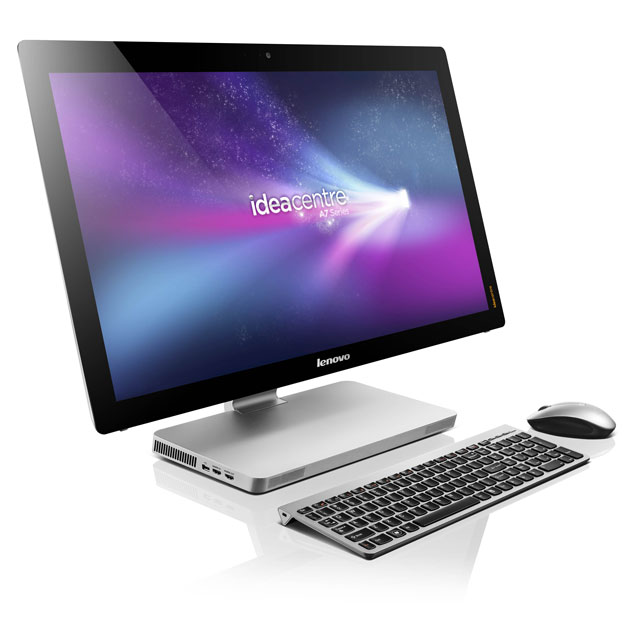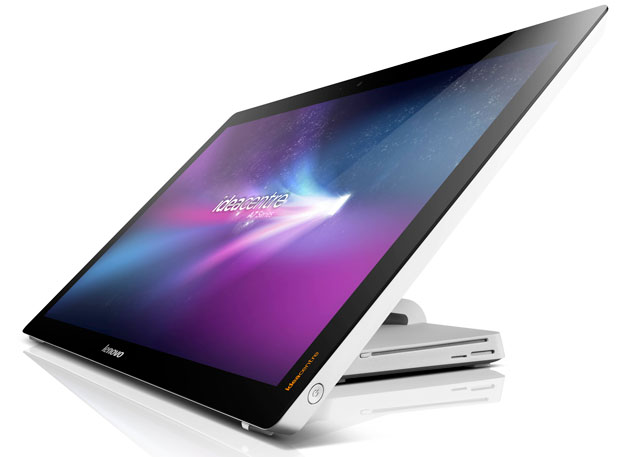
Internationally, a number of PC manufacturers are jumping on the all-in-on desktop bandwagon in the wake of the success of Apple’s iconic iMac, but in SA the options are still limited. Chinese electronics manufacturer Lenovo is one of the few to try flogging its all-in-one machines in the SA market. The IdeaCentre A720 is an excellent PC with a wide range of innovative features and functionality that play to the strengths of its design. It is, however, let down somewhat by the resolution of its otherwise impressive display.
The 27-inch, 1 920×1 080-pixel, 10-point multi-touch and capacitive screen is impressive at first glance, and even more so at first touch, but in practice the resolution is simply too low for a display of its size. While it is full HD, and looks great when playing content using the built-in Blu-ray player, the pixels are noticeable — uncomfortably so — when dealing with large bodies of text.
When it comes to monitors intended for PC use, 24-inch displays should be the upper limit for 1 920×1 080 resolution. We’d have liked to have seen Lenovo follow Apple’s lead with the 2 560×1 440-pixel resolution found in its 27-inch iMac.
Of course, part of the reason for the Lenovo all-in-one’s resolution is the cost involved. The A720’s display is the capacitive sort usually reserved for tablet computers and smartphones rather than the cheaper optical touch displays commonly used in screens of this size. The benefit of this approach is excellent responsiveness and accuracy.
The brightness of the display, system volume and other settings are all controlled using capacitive buttons on the bottom right of the display, while the bottom left has indicator lights for hard drive activity, power and Bluetooth and Wi-Fi status.
The display’s hinged arm means it can be raised, lowered, or even laid on its back. This, combined with its 10-point touch functionality makes the A720 ideally suited for activities like casual gaming, education and even, to a lesser extent, animation, design, photo editing and similar applications — particularly if one has a touchscreen stylus to hand.

It takes a little getting used to having a touchscreen on a desktop, but the potential applications are fantastic, and it’s this potential that Microsoft is banking on with Windows 8 and its Metro user interface. With smartphones and tablet computers becoming ever more ubiquitous and touchscreens appearing on ATMs, maps of shopping malls and other interactive displays, the move to desktops is inevitable.
What’s the first thing you do when you get a touch-enabled desktop PC? Why, you stick the Windows 8 release preview on it, of course. Though the A720 ships with Windows 7 Home Premium or Professional, the device is ideally suited to Windows 8, and users investing in it will certainly be planning to make the upgrade themselves once the operating system is commercially available at the end of October.
The A720 is perfectly suited to Windows 8’s touch-friendly interface. Hitting the Start button brings up the new Start screen, complete with live tiles and shortcuts that can be thoroughly customised. Scrolling through lengthy Web pages with a finger is a delight and it’s often quicker to double-tap a desktop icon than to navigate to it with the mouse.
Aside from the screen resolution, the only obvious shortcoming of the A720 is the supplied mouse. It feels cheap and flimsy, which really isn’t in keeping with anything else about the machine. The keyboard feels somewhat classier, even though it’s clad in the same chrome-coloured plastic.
Both keyboard and mouse are wireless and connect to the A720 using a small USB dongle. It’s unfortunate that Lenovo didn’t opt for built-in Bluetooth connectivity for connecting the peripherals as the dongle means sacrificing one of the four USB ports.
In terms of connectivity, the A720 offers a pair of USB 2.0 and a pair of USB 3.0 ports, a card reader, the requisite audio-in and audio-out 3,5mm jacks, a pair of full-sized HDMI ports, and users can even opt for a TV tuner when customising specifications.
The option of a TV tuner and the HDMI connectivity makes a lot of sense in a device like the A720 because, aside from basic computing, what it’s really well suited to is entertainment. With its massive HD display, the A720 makes for a great video viewing device. The on-board sound is respectable, if not a little tinny when the volume is high, and Lenovo clearly intends this to be as much a media machine as a home PC.
This no doubt explains Lenovo’s decision to include a remote control — and accompanying USB dongle — with the A720. It’s a sensible addition that further improves the unit’s functionality and makes it a pleasure to adjust volume or control media players without having to be right in front the machine.
Available in various configurations, our review unit included a Core i7 2,3GHz processor, 8GB of RAM, an NVidia GeForce GT 630M GFX card with 2GB of memory, a Blu-ray ROM, a 64GB SSD for core functions like boot-up, and a 750GB hard drive.
Screen resolution aside, the A720 is an extremely impressive device. It really lifts the bar in terms of all-in-one PCs and demonstrates just some of the benefits touch displays offer for PC devices. Sadly, however, capacitive displays don’t come cheap, which is why the A720 starts at R18 999. It’s not perfect, but it’s innovative and definitely hints at what we can expect from PCs in coming years. — (c) 2012 NewsCentral Media

